What can we learn from not-for-profit employees about why purpose matters most?
For the Love of Purpose
What We Did
The Context
A deeper understanding of why they make that sacrifice may not only provide us valuable insights into how the workplace environment can be designed to better support them, but also points to broader ways that design can contribute to a brighter era of work itself. While our research led to some encouraging findings, it also exposed a serious problem for not-for-profits: While engagement is better among employees in the not-for-profit sector, turnover is still high. In fact, talent retention is cited in most industry surveys as one of the biggest challenges facing not-for-profit organizations. Our research presents an exciting opportunity for not-for-profits to engage their employees, reduce turnover, and achieve overall higher performance.
The Results
On the other end of the motivational spectrum is extrinsic motivation, action carried out to earn a reward or avoid punishment. In the realm of work, extrinsic rewards include raises, bonuses, promotions, and praise, but also deadlines, pressure, rules, and bureaucracy.
Studies have proven extrinsic motivation to be highly ineffective in driving performance, often an impediment to it. Nonetheless, extrinsic rewards remain at the core of most corporate engagement initiatives and performance strategies.
Employers have enormous power to facilitate intrinsic motivation; they can align work to individual strengths, reinforce connection to the mission of the organization, and de-emphasize extrinsic rewards and regulations. To do so, employers must reimagine themselves not as enforcers of productivity, but enablers of meaning.
Workplace environments are a key lens through which employees “read” the culture of their organizational culture, whether intentional or not. A well-designed workplace can be a powerful tool to foster intrinsic motivation, and reduce turnover as a result. Even better, the other organizational benefits made possible by an increase in intrinsic motivation include a more engaged, healthier, collaborative, self-directed, resilient, enthusiastic, and loyal workforce.
Most importantly, in a sector taking on some of the most daunting challenges facing society today, intrinsic motivation is a key driver of innovation. Incremental innovation may occur through extrinsic motivation, but true, game-changing, transformational innovation—the kind that organizations across all sectors need today only comes from a fire within individuals (a flame that can be fed or extinguished).
What This Means
Meaning is a feeling, not a message. Resolving the entrenched disengagement of the U.S. workforce will not take place through space-planning alone—the solution must be transformational. We must create environments where, more than just communicating mission, people experience mission and organizational meaning directly.
Make engagement a key metric and track it. The workplace presents organizations with an unmatched opportunity to amplify engagement and emotionally connect with workers. In every design decision there is an opportunity to increase employee engagement: from site selection, building orientation, and spatial configuration, to the color of the paint on the wall.
Purpose shouldn't just be for not-for-profits. Employees in not-for-profit organizations have a leg up—they’ve chosen a career path directly connected to motivation and purpose. Nonetheless, there are lessons to be learned for any organization and workplace. Grappling with design’s power to drive purpose can be a key goal of any workplace.
What’s Next?
Learn More
Team
Lisa Amster, Erik Lucken, Elaine Asal, Lisa Bottom, Amanda Ramos
Year Completed
2016
Comments or ideas for further questions we should investigate?
